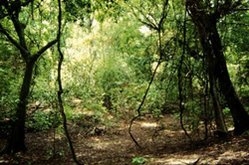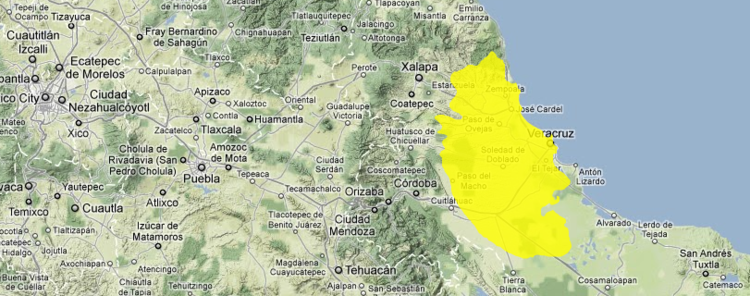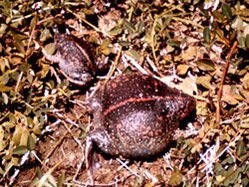Veracruz dry forests
The dry forests of Veracruz constitute an ecological island in the middle of tropical forests.
The region is considered among the richest regions for herpetofauna in Mexico. Avifauna diversity is high with over 280 species, and more than one hundred species of mammals are found here.
Most of the original forest has been replaced by scrub and secondary communities.
Pollution, human development, and cattle raising are the main threats to the remaining habitat.
Location and General Description
The region is located in the coastal plain of central Veracruz, north of the Santa Martha and San Andrés volcanoes.
The climate is tropical dry due to the orographic influence of the Chiconquiaco Sierra Mountains. The soils are calcareous and derived of sedimentary rocks. The area is relatively humid (<1000 millimeters (mm)/year). These characteristics allow the development of a dry forest along the coast, near Veracruz city.
In this forest a long dry season forces the plants to shed their leaves completely for several months. Dominant species are Cordia dodecandra, Tabebuia chrysantha, Piscidia piscipula, Crescentia alata, Enterolobium cyclocarpum, Ehretia tenuifolia and Tabebuia rosea. Cacti are common in these forests, and include species of Acanthocereus, Agave and Nopalea. Herbaceous plants are scarce, however some epiphytes and shrubs do occur. The most diversified species belong to the genera Acacia, Busera, Ficus, Phyllantus, and Pithecellobium.
Biodiversity Features
The dry forests of Veracruz constitute an ecological island in the middle of a sea of tropical forests. They are also the northernmost tropical dry forests on the slopes of the Mexican Caribbean. The region is considered among the richest regions for herpetofauna in Mexico. The forests constitute the preferred habitat for many birds, including migratory species that use the coastal environments of the region as a stopover during their migratory route. The avifauna of this region comprises over 280 species, of which, approximately 85 are dry forests specialists. There are approximately 100 species of mammals that use this habitat.
Avifauna diversity is high and includes: Sharp-shinned hawk (Accipiter striatus), merlin (Falco columbarius), white-winged dove (Zenaida asiatica), lesser roadrunner (Geococcyx velox), Mexican sheartail hummingbird (Doricha eliza), Couch’s kingbird (Tyrannus couchii), Swainson’s thrush (Catharus ustulatus), red-eyed vireo (Vireo olivaceous), magnolia warbler (Dendroia magnolia), and blue-black grassquit (Vilatinia jacarina).
Current Status
Most of the Veracruz dry forest has been eliminated. Rzedowski estimates that the forests have been destroyed almost completely, and have been substituted by scrub and secondary communities. Species that were once abundant in the region are now the rare in any floristic inventory, as in the case of the once common and now very scarce Bursera cinerea. Toledo & Ordoñez confirm that vast portions of the forests have been extensively logged. From 1900 to 1987, over 18,553 km2 of the forests in the state of Veracruz were logged, including major portion of the dry forest. Agricultural expansion has also eliminated vast extensions of forest. Large fields of fruit and coffee plantations have substituted the original vegetation in much of this region, which has lead to extensive erosion.
Types and Severity of Threats
Human settlements in the region threaten the survival and integrity of the system. Pollution associated with human activities is severe, and has affected the trees in the area. Cattle raising and agricultural practices of local subsistence farmers, and is one of the main factors involved in the current destruction of these forests. The state of Veracruz is one of the major cattle farming [[region]s] in Mexico, and sustains huge herds. Exploitation of piroclastic deposits for the building industry also contributes to habitat destruction and perturbation of soils, diminishing the ability of forest to regenerate. There is one small protected area created to preserve some of the last remnants of dry forest in the state of Veracruz, which also serves as a Biological Station.
Justification of Ecoregion Delineation
This patch of lowland dry forest is completely surrounded by moist forest [[habitat]s]. It is bound on the east by the Gulf of Mexico, and to the west by the moist eastern slopes of the Sierra Madres. The linework for this ecoregion follows INEGI, by lumping the following vegetation classifications of their map: "lowland deciduous forest", "grasslands", and all agricultural areas within the broader delineation’s. This was then reviewed and modified by expert opinion during several ecoegional workshops.
References
- Barrera-Bassols, N., C. López, y R.Palma. 1993. Vacas, pastos y bosques en Veracruz: 1950-1990. In N. Barrera, y H. Rodríguez, editors, Desarrollo y medio ambiente en Veracruz. Fundación Friedrich Ebert, México.
- Challenger, A. 1998. Utilización y conservación de los ecosistemas terrestres de México. Pasado, presente y futuro. Conabio, IBUNAM y Agrupación Sierra Madre, México.
- CONABIO Workshop, 17-16 September, 1996. Informe de Resultados del Taller de Ecoregionalización para la Conservación de México.
- CONABIO Workshop, Mexico, D.F., November 1997. Ecological and Biogeographical Regionalization of Mexico..
- Flores-Villela, O. 1993. Herpetofauna de México: distribución y endemismo. Pages 251-279 in T. P. Ramamoorthy, R. Bye, A. Lot, y J. Fa, editors, Diversidad Biológica de México. Orígenes y Distribución. Instituto de Biología, UNAM, Mexico.
- Gómez-Pompa, A. 1977. Ecología de la vegetación del Estado de Veracruz. CECSA, México.
- Hernández-Ibarra, A., y H. García-Campos. 1992. La gestión ambiental en el municipio de Xalapa. In E.Boege, y H. Rodríguez, editors, Desarrollo y medio ambiente en Veracruz. Fundación Friedrich Ebert. Instituto de Ecología, A.C., México.
- INEGI Map (1996) Comision Nacional Para el Conocimiento y Uso de la Biodiversidad (CONABIO) habitat and land use classification database derived from ground truthed remote sensing data Insitituto Nacional de Estastica, Geografia, e Informática (INEGI). Map at a scale of 1:1,000,000.
- Ortiz-Pulido, R. 1994. Frugivoría y dispersión de semillas por aves en el Morro de la Mancha, Ver. Tesis de Licenciatura, Facultad de Biologia, Universidad Veracruzana, Xalapa, Veracruz, México.
- Ortiz-Pulido. R., Gómez de Silva, H., González-García, F. & Alvarez, A. 1995. Avifauna del centro de investigaciones costeras la Mancha, Veracruz, Mexico. Acta Zool. Mex.(n.s.) 66: 87-118.
- Rzedowski, J. 1978. Vegetación de Mexico. Editorial Limusa. Mexico, D.F., Mexico.
- Rzedowski, J. pers.comm. at CONABIO Workshop, 17-16 September, 1996. Informe de Resultados del Taller de Ecoregionalización para la Conservación de México.
- Rzedowski, J., y G. Calderón de Rzedowski. 1996. Nota sobre Bursera cinerea Engl. (Burseraceae) en el Estado de Veracruz. Acta Bot. Méx. 37: 33-38.
- Toledo, V. M., y M. J. Ordoñez 1993. El panorama de la biodiversidad en México: una revisión de los habitats terrestres. Pages 739-758 in T. P. Ramamoorthy, R. Bye, A. Lot, y J. Fa, editors, Diversidad Biológica de México. Orígenes y Distribución. Instituto de Biología, UNAM, Mexico.
- Toledo, V. M., J., Carabias, C. Toledo, y C. González-Pacheco. 1989. La producción rural en México: alternativas ecológicas. Colección Medio Ambiente, no. 6. Fundación Universo Veintiuno, México.
| Disclaimer: This article contains information that was originally published by the World Wildlife Fund. Topic editors and authors for the Encyclopedia of Earth have edited its content and added new information. The use of information from the World Wildlife Fund should not be construed as support for or endorsement by that organization for any new information added by EoE personnel, or for any editing of the original content. |
Citation
World Wildlife Fund (2014). Veracruz dry forests. Mark McGinley and C. Michael Hogan. Encyclopedia of Earth. NCSE. Washington DC. Retrieved from http://editors.eol.org/eoearth/wiki/Veracruz_dry_forests


